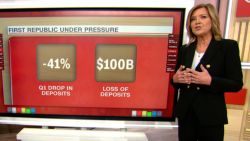Let’s be frank: If you have a US bank account, hearing about bank failures in the past couple of months hasn’t felt great.
After all, a bank is supposed to be the safest, most boring place to keep your money, not the reason you reach for Advil.
Well, guess what? A bank is still the safest place to keep your money, and will continue to be even though some banks will fail from time to time.
Here’s what you need to know to keep things in perspective despite the recent closures of First Republic, Silicon Valley Bank and Signature Bank.
How do I know my money is safe?
If you have accounts at a financial institution that is insured by the Federal Deposit Insurance Corporation, you can be confident your deposits will be covered at least up to $250,000. And in some circumstances it could be more.
Here’s why: Each deposit account owner will be insured up to $250,000 — so, for example, if you have a joint account with your spouse, your money will be insured up to $500,000. Or if you have your own personal checking account and a jointly held business checking account at the same bank, your money in each of those accounts will be insured up to $250,000.
The story is similar at federally insured credit unions. If that’s where you hold your money, your deposits are insured at least up to $250,000 by the National Credit Union Administration, which, like the FDIC, is backed by the full faith and credit of the US government.
How can I know if my bank will fail?
You can’t. If a bank does run into trouble, only those privy to the bank’s books are the most likely to see it coming first.
“[Customers] would need to be keeping track of their bank’s financial statements, regulatory filings, audit statements and other such materials to be able to identify red flags,” said Marbue Brown, a former JP Morgan Chase customer experience executive who now works as a Fortune 500 executive consultant.
Plus, much of the information that would help you truly gauge the health of your bank is not public, such as deposit inflows and outflows, credit losses and funding sources. And to the extent they are reported, it is on a lagged basis at the end of each quarter.
What should I do if my bank fails?
Every resolution of a bank failure is a little different.
The FDIC will issue information within a day or so of taking over a failed bank to let the bank’s customers know what steps if any they need to take and when. The best place to look for that information is on the agency’s failed banks list.
But generally speaking, when the FDIC takes over a bank it makes every effort to ensure customers have immediate access to their money and to preserve a seamless continuation of banking services, even if it’s under a temporary “bridge” bank that the FDIC may establish to handle customers’ accounts as it seeks to find a permanent home for the failed banks’ assets and liabilities.
In the case of First Republic, all of First Republic customers’ deposits were immediately acquired by JPMorgan Chase and there was no interruption of banking services.
So I shouldn’t care if another bank that isn’t mine fails?
Mostly, no. It won’t affect your bank accounts.
That said, other banks’ failures offer everyone a good reminder:
If you are fortunate to have more than $250,000 stored at a single bank, review just how much of your money would be covered by FDIC insurance should your bank ever fail. (Use the FDIC’s Electronic Deposit Insurance Estimator.)
If it turns out, say, your own checking and savings combined add up to more than $250,000 then you should transfer any money over that threshold and deposit it at another FDIC-insured bank. That way all of your money will be adequately insured.
“[It’s] is a wake-up call for people to always make sure their money is at an FDIC-insured bank and within FDIC limits and following the FDIC’s rules,” said Matthew Goldberg, a Bankrate analyst.
CNN’s Ramisha Maruf contributed to this report.

























